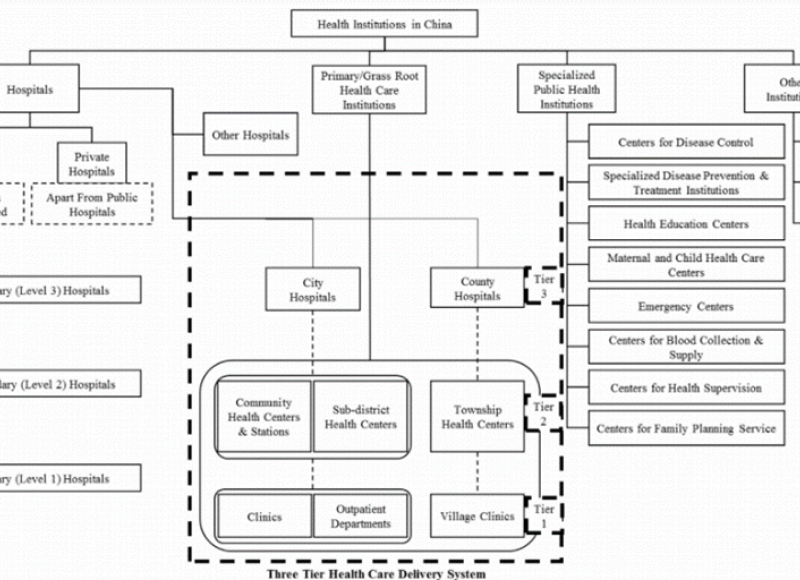China Health System Overview
Population - Cancer and Chronic Disease
- Current estimated population of 1,400m1 (~18% of the world’s population)2
- Ischemic heart disease, lung cancer and stroke, COPD and liver cancer are the leading causes of premature death3
- Cancer is one of the leading causes of death in China (29% of all deaths in 2018)4
- The most common cancers are Lung, Colorectal, Stomach, Liver and Breast5
- National diabetes rates increased by 50% between 2000 and 20176
Healthcare System Overview7
- China has identified universal health coverage as a key priority with most of the population having basic coverage through various social health insurance schemes (e.g. rural cooperative medical scheme, employee-based health insurance schemes and resident-based health insurance schemes).
- There are four levels of health administration with the National Health and Family Planning Commission (NHFPC) leading nationally and then health authorities at provincial, city and council levels providing services locally. Each level has a medical service delivery system (diagnosis and treatment) and a public health delivery system (disease prevention and control)
- The NHFPC is a member of the state council and has 21 departments that oversee different aspects of the healthcare landscape
- Private hospitals account for more than half (57%) of the total hospital beds in the country with the total number of private hospitals doubling between 2011 and 20178
- The China Food and Drug Administration is responsible for approvals of new pharmaceuticals and medical devices. There is a national essential medicines list with medicines sold at controlled prices. Each province can select medicines to supply in addition to the national essential medicines list.9
Image

Source: Qingyue M, Hongwei Y, Wen C, Qiang S, Xiaoyun L. People's Republic of China Health System Review. Vol.5 No.7. Manila: World Health Organization, Regional Office for the Western Pacific, 2015.
Health Costs and Funders
- In 2017 total health spending was $611 billion (USD), equating to $441 per person and 5.2% of GDP10
- Health expenditure as a percentage of GDP has increased by 24% from 4.2% in 201011
- It is estimated that a little over half of health costs come from public expenditure and the rest comes from social expenditure, private health insurance and other sources12
- Major expenditure categories include hospitals, local health centres, pharmacies/pharmaceuticals, ambulatory health facilities and community-based health care services.13
- Estimated 40% of total health expenditure is on pharmaceuticals14
Health Systems Challenges
- An aging population with the population over 65 increasing, currently an estimated 11.5% of the total population15
- Growing burden of chronic disease16 and high rates of smoking17
- Gaps in standards of care between urban and rural medical services18
- Growing demand for high quality primary care services and a potential for better health services integration and coordination19
Sources
- United Nations Department of Economic and Social Affairs, World Population Prospects 2019 Data Booklet, p17
- World Bank Open Data, https://data.worldbank.org/ used in reporting of figures and calculation of percentages.
- http://www.healthdata.org/news-release/chronic-conditions-not-infectious-diseases-are-top-5-causes-early-death-china
- World Health Organization International Agency for Research on Cancer, China Fact Sheets
- World Health Organization International Agency for Research on Cancer, China Fact Sheets
- World Health Organization International Agency for Research on Cancer, China Fact Sheets
- Qingyue M, Hongwei Y, Wen C, Qiang S, Xiaoyun L. People's Republic of China Health System Review. Vol.5 No.7. Manila: World Health Organization, Regional Office for the Western Pacific, 2015
- http://www.xinhuanet.com/english/2017-08/12/c_136520821.htm
- https://www.euro.who.int/__data/assets/pdf_file/0020/320465/Pharmaceutical-policy-China-challenges-opportunities-reform.pdf?ua=1
- World Bank Open Data, https://data.worldbank.org/ used in reporting of figures and calculation of percentages.
- World Bank Open Data, https://data.worldbank.org/ used in reporting of figures and calculation of percentages.
- Qingyue M, Hongwei Y, Wen C, Qiang S, Xiaoyun L. People's Republic of China Health System Review. Vol.5 No.7. Manila: World Health Organization, Regional Office for the Western Pacific, 2015.
- Qingyue M, Hongwei Y, Wen C, Qiang S, Xiaoyun L. People's Republic of China Health System Review. Vol.5 No.7. Manila: World Health Organization, Regional Office for the Western Pacific, 2015.
- https://www.euro.who.int/__data/assets/pdf_file/0020/320465/Pharmaceutical-policy-China-challenges-opportunities-reform.pdf?ua=1
- World Bank Open Data, https://data.worldbank.org/ used in reporting of figures and calculation of percentages.
- http://www.healthdata.org/news-release/chronic-conditions-not-infectious-diseases-are-top-5-causes-early-death-china
- https://www.euro.who.int/__data/assets/pdf_file/0020/320465/Pharmaceutical-policy-China-challenges-opportunities-reform.pdf?ua=1
- http://www.healthdata.org/news-release/chronic-conditions-not-infectious-diseases-are-top-5-causes-early-death-china
- https://www.thelancet.com/journals/lancet/article/PIIS0140-6736(20)30122-7/fulltext
